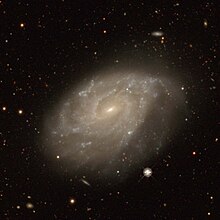| NGC 1255 | |
|---|---|
 NGC 1255 (NASA/ESA HST) | |
| Observation data (J2000.0 epoch) | |
| Constellation | Fornax |
| Right ascension | 03h 13m 32.04s [1] |
| Declination | −25° 43′ 30.60″ [1] |
| Redshift | 0.005624 [1] |
| Heliocentric radial velocity | 1686 ± 3 km/s [1] |
| Distance | 69 Mly [1] |
| Apparent magnitude (V) | 10.7 [2] |
| Apparent magnitude (B) | 11.5 [2] |
| Characteristics | |
| Type | SBbc [2] |
| Apparent size (V) | 4.2 x 2.6 [1] |
| Other designations | |
| PGC 12007, UGCA 60, AM 0311-255, MCG -4-8-50, ESO 481-13 | |
NGC 1255 is a barred spiral galaxy approximately 69 million light-years away from Earth in the constellation of Fornax. [1]
